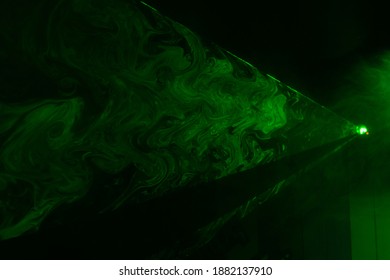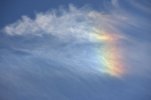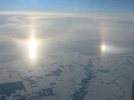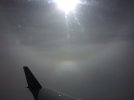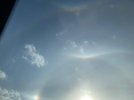Since it was described by Bowyer as below the sun I wonder if he was observing some part of a subhorizon arc, parallel to the parhelic arc, given an "eliptical blur" shape by cloud / haze.
The sighting took place when they were flying in an evelope of clear visibility between haze layer below and cloud cover above.
"there was a layer of thin haze below the aircraft at approximately 2000ft" (p.79)
"Cloud overcast at about 8,000 feet." (p.132)
"Visibility was estimated by Capt Bowyer at 100nmi above the haze" (p.86).
Sun “was behind clouds but virtually straight ahead” (p.133)
Object was slightly to the right and “same height as the aircraft” (p.134)
In dismissing the sundog hypothesis the NICAP report (p.60) says:
Two lights near the horizon, almost directly below the sun and just a few degrees apart, are not sundogs.
But could they have been subsun dogs, or some part of the subhorizion arc visible in the haze layer below them? [assuming the subsun itself was obscured by the body of the aircraft]
A rough approximation using Bowyers illustration (p.9) of what he saw and the subhorizon arc diagram overlaid from https://atoptics.co.uk/halo/subhor.htm.

The "dark area"
“these two objects were both to the same side of the sun“ (p.151)
“The dark areas were darker than the yellow part of the object and lighter than the background (haze/ground). The dark was a “graphite grey” colour. The dark bands oscillated on both objects. “ (p.144)
Could the "dark area" in Bowyers drawing be the intersection between the parhelic arc and halo?
Because of the cloud above they may not have noticed the halo or even the whole complex array of atmospheric effects that
Mike Maunders suggested the conditions were right to provide.
Atmospheric phenomenon (sundogs/subsun) are put way down on the list of possibilities (p.111), apparently
only because of the description of the objects moving in relation to each other. (but again it's not clear where that description comes from).

However no movemnt is described in the interviews with Bowyer, his passenger Kate Russell or the pilot in the other plane Capt Patterson.
Bowyer says the objects “
appeared stationary” and “
always appeared stationary” (p.123 & 125, 126).
In his interview he says:
“Only due to the relative position of my aircraft did the second object
appear to 'move' left” (p.149)
Capt Patterson says there was “
No apparent motion” of the object (p.156)
Yet the report includes this claim:
"during the course of 6 minutes Capt Bowyer observed the two UAPs steadily cross each other from left to right, horizontally, over an arc of a few degrees.” (p.113)
I can’t find anywhere where bowyer says this on the record, it's not in his TV interviews or the interviews he gave for the NICAP report: that the objects moved in this way, or even moved in relation to one another at all!
Discrepancies in eyewitness accounts.
Bowyer could see the sea horizon and there was cloud cover above. (but when asked if he could see any ships says “Cannot recall seeing any but it was
very hazy below the aircraft” (p.137).
Yet his passenger Kate Russell says “whilst I was watching the second time I could clearly see a little fishing boat on the sea below” (p.150)
Bowyer “The objects were seen against both the sea and the Islands.” (p.145)
“The horizon was visible at all times. The haze layer itself forms a horizon as it disappears off to the horizon! The sea and the haze layer merge at the horizon. At 2000 ft items or objects at or on the top of the haze layer are shrouded by the dirt in the air.“ (p.149)
Yet Capt Patterson says when asked “Was the horizon clearly discernable despite any haze/cloud?
Says,
"No" (p.156)
While Bowyer describes the object as "very sharply defined" Patterson describes the object as a just “hazy patch” (p.156)
“At the time of last sighting both objects were visible on the horizon i.e. the haze horizon which coincides with the actual horizon.
Both objects disappeared from my view simultaneously at 2000 ft.” (p.149)
This suggests a link between the objects and the haze layer - it seems necessary for the observation - and since the objects were not seen from the ground and didn't apparently move perhaps the atmospheric phenomenon hypothesis deserves another look.
[all quotes and page numbers above are from the NICAP report
http://www.nicap.org/reports/070423channel_islands.pdf]

